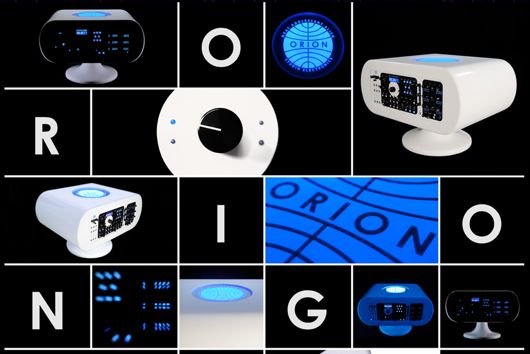
Studio Electronics has introduced the Orion Galaxy Omega 8 – a new synth that looks to be the most sextacular new piece of electronic gear in a long cold while.
It’s inspired by Stanley Kubrick’s retro vision of the future 2001: A Space Odyssey:
what is this? it is art. it is light. it is glorious design brought to life by Antoine Argentieres, the man, who sagely let his fondness for Stanley Kubrick’s past century enigmatic odyssian vision of the future (and re-visioning of pivotal past events) inspire a house fit for the majestic voice and verve of the Omega8––a cathedral of transformation; the great work of the synth; a mind before matter mystical alignment of awareness: light and sound waves that reveal the ORION GALAXY, expanding and growing and luminous.
SE doesn’t have specs for the Orion Galaxy Omega 8 up, but this appears to be a sexy version of the Omega 8, and that’s OK by me. Sexy is good.
Here’s the Omega 8 specs:
Description:
The Omega 8 is an eight-voice, discrete circuit, multi-timbral, stereo, multi filtered, arpeggiating, DSP free Analog Dream Machine. Overflowing with elaborate MIDI control, dynamic signal processing, and expansive modulation, its sound creation and manipulation could very well exceed the boundaries of your imagination. Apparitional pads, foundational basses, revelatory leads, electrosonic drums, other-worldly sound effects and utterly massive synthetic soundscapes… The Studio Electronics Omega8 delivers true ANALOG stimulation. Exactly what you need to compete and remain a vital force in today’s highly charged musical ecology.
General Specs:
Voices: eight.
Multitimbrality: eight part; Parameters: patch, number of voices, mono or poly.
Audio outputs: one stereo per voice. One main stereo and main mono output.
Interface: 32 knobs (relative and jump modes), I rotary encoder, 35 tactile switches, 24 LEDS.
Display: 16 x 2 back lit liquid crystal.
Memory: 256 sound patches,128 multi patches in RAM.
Weight: 20 lbs.
Dimensions: 4 rack spaces, 15 inches deep.
Power: 90 – 250 volts AC auto switching.
Voice Architecture
Two voltage controlled discrete analog oscillators and one sub wave of Oscillator 1
Waveforms: triangle, sawtooth and variable width square. All waveforms output simultaneously. Syncing of Osc 2 to Osc 1.
Two voltage controlled discrete analog filters
24db (classic Moog), 12 db (classic Oberheim). 12db filter has low pass, bandpass, high pass and band reject modes. Each voice has the capability of having four different filters available for use. Additional filters (up to 2 per voice) can be added as desired in any number. Filters do not operate in series or parallel. Current additional filters available: Roland 303, Arp 2600.
Three low frequency oscillators (LFO3 fixed to voice panning)
Waveforms: triangle, sawtooth, reverse sawtooth, square, noise, random. Up to three destinations and depths each for LFOs 1&2 with range, delay, key trigger, phase, mode (mono or poly), quantize, midi sync.
Three multiple stage envelope generators
Attack, decay, sustain and release with inverting and multiple triggering. Envelopes 1&2 have additional delay, decay2, and breakpoint parameters. Envelope 1 fixed to filter frequency. Envelope 2 fixed to amplifier level. Envelope 3 is assignable with up to three destinations and depths.
Arpeggiator
Parameters: tempo, direction, range, interval, midi sync.
Glide
Linear or exponential. Parameters: time, mode (auto, legato, glissando), autoglide interval, dynamics, destination.
Unison mode
One, two, four, six, or eight voices.
Additional Features
Oscillator 2 audio frequency modulation. Destinations: Osc 1 frequency, Osc 1 pulse width, filter frequency. White noise generator. Auto triggering external input processor on each voice. Parameters: input level, trigger level, mix level, window.
Modulation Destinations
LFOs1&2 and envelope 3: VCO 1&2 frequency, pulse width, and mix level, VCF frequency and resonance, noise level, Xmod amount, LFOs 1&2 rate and depth, VCA level, external mix level.
MIDI Specifications
In out and thru. Receives: program change, bank select, glide on/off, glide time, volume, SYSEX. Controllers: dynamics, modwheel, bender, pressure destination and amount (x2). Controller 1 assignment: dyn, mod, pressure, bend, tracking, continuous cont #2 (x2), controller 1 amount (x2). Controller 2 assignment – same as controller 1 (x2), controller 2 amount (x2). Dynamics, tracking, and bender have positive and negative modulation. Fixed continuous controller assignments for all key functions.
MIDI Controllers
Dynamics, modwheel, bender, pressure, tracking, breath controller: all LFO1&2 and envelope 3 destinations, including envelopes 1, 2, and 3 attack, decay, sustain, release, amount.
